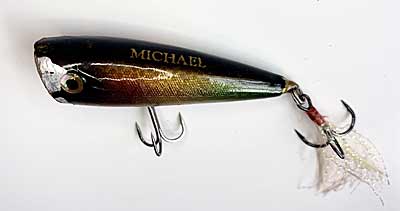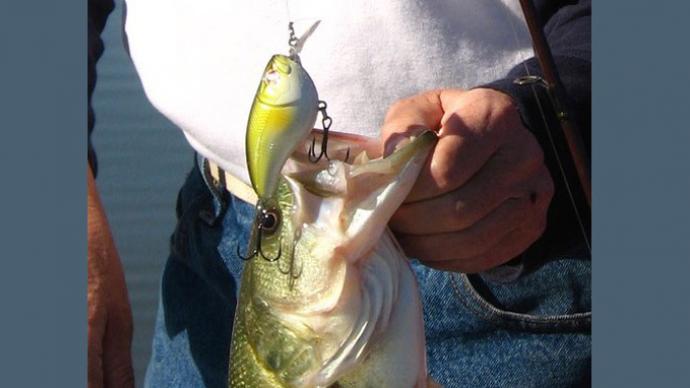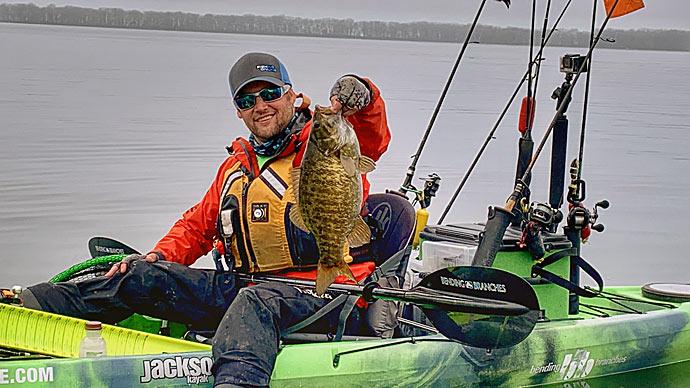
My introduction to Japanese baits came almost 30 years ago. I walked into my favorite tackle shop and Walt, a fellow tournament angler, was behind the counter. “Hey,” he said, “I’ve got something you might be interested in.” He led me into the back room and took a small box off the desk. Inside was a slim popper with a slanted and barely cupped face. Stamped on the back of the lure was the name Michael and a small heart. “Twenty-five bucks,” he said. Twenty-five bucks! Thirty years ago, that was a LOT of money for a lure. They don’t call them lures for nothing – I bit. The following weekend I caught my up-to-then PB at Lake Pleasant – an 8-pounder that smashed the Michael the instant it splashed past a bush. That was the thing about the Michael – it splashed and spat rather than blurping, and it was different. I lost that first Michael years later, but I bought another. At some point, the heart went away, but you can still see the name Michael on the back of the lure.
I’ve used that bait so much that the paint is starting to chip off – after thirty years. That is one of the best things about quality Japanese baits: they are very well made and durable. Munenori Kajiwara of JapanImportTackle.com says that the Japanese people are good at making products and at quality control. From automotive to fishing lures, he says, “Made in Japan” is a symbol for the highest quality products. Japanese products are beautiful, highly functional, inventively designed, and last longer than most others, which is part of the reason that they often cost more. Japanese baits are already expensive in Japan, he says, because of better (more educated) labor, higher quality control, and better materials. To those costs must be added international shipping, US Customs duty, federal excise tax, and then U.S. domestic shipping. It all adds up.
Alex Atack, aka @japanesebassman on Instagram, agrees that Japanese baits are super high quality. Since he is half Japanese, he has been to Japan many times, and he says everything there testifies to their aesthetic of beauty, attention to detail, and quality. “With the Japanese, there is no room for error,” he says. “The trains are always on time, there is no trash on the streets, and politeness is the norm.” There are many Japanese baits that Alex fishes routinely, although he says he rarely posts a photo of a fish with the bait he caught it on. He loves the Jackall TN50, 60, and 70 lipless crankbaits. Jackall Baits was started in 1999 by Japanese lure designer Seiji Kato and tournament angler Ty Ono. They have partnered with Shimano North America since 2010, and their website says that the products available in the U.S. “are created with U.S. waters, techniques, bait colors, and needs in mind.”
When I talked to Takahiro Omori about Japanese lures, that was one thing he mentioned immediately. “Bait designers in Japan make baits with Japanese people in mind,” he says. “The baits are often designed for fishing smaller ponds and for the techniques that Japanese fishermen use.” They may also have different baitfish, meaning that colors to match the hatch in Japan may not work well here. The Japanese baits that Takahiro likes are the Lucky Craft baits. He says they are 100% made in Japan and designed with American fishermen and waters in mind. Still, not all of the baits on their website are available in the U.S. Tako says an excellent place to look for Japanese baits is tacklewarehouse.com, in the JDM Tackle section. Takahiro says he tries to follow the new trends, but they don’t all work here, and he doesn’t have the time, so he generally waits a couple of years to see if they stay popular.
That said, Tako’s favorite Japanese baits are the Evergreen Jackhammer, a vibrating jig designed by Brett Hite with the Japanese lure maker Evergreen International, and of course, like every other fisherman, he loves Gary Yamamoto baits. Yamamoto’s Kut Tail, Senko, and Leg Worm are also among the top ten soft baits in Japan as well.
Omori is also a big fan of Lucky Craft, especially the Sammy 105. This is a new version of their famous Sammy topwater that is fished with a walk-the-dog technique. It includes a single knocker to sound like a baitfish clicking across the water. He also likes the Screw Pointer 85, a new bait. Takahiro says it’s a spy bait with three hooks – great for suspended smallmouth, he’s found. He fishes it with a steady retrieve on 8-pound-test line with a long cast. He lets it sink for about five seconds, then fishes it back for suspended fish.
Munenori Kajiwara (Japan Import Tackle) told me that his go-to bait for big bass outside the spawn is the Gan Craft Jointed Claw, Gan Craft Jointed Claw, which is a big S-motion glide bait. This bait comes in various sizes and colors and also in a slow-sinking version as well as a floating version. It swims with a beautiful S-curve if you fish it with a steady retrieve. Or, you can fish it slow and mix in a few twitches, or let the sinking one (slow sinking) go to the bottom and rip it. It’s made with typical Japanese quality – Owner Hooks, replaceable rubber tail, and incredible finishes.
Other baits that Kajiwara finds notable are the Gan Craft Bacra, which has a distinctive wobble and creates a water stream that attracts larger bass; The RAID Japan Level Crank, a slow sinking, level-swimming crankbait that doesn’t roll on its side even when it hits bottom; Imakatsu Waddle Baits with a rear blade system for a very erratic “drunk walk” that triggers strikes; and the Imakatsu Scare Brow 7 with a front blade to make it snagless.
Fishing Smaller Waters From Shore
Alex Atack was very open about how he fishes his favorite Japanese baits. He often fishes the Jackall 50, 60, and 70 and says they are very versatile baits. “Most guys fish a lipless crank with a traditional straight retrieve,” he says, “but I rip it up and down like a yo-yo.” These baits cut through the water and look like a bait fish falling. He likes the RT Holo Bluegill color. “The finishes on these baits are amazing,” he says. “The Japanese pay so much attention to detail.” For the lipless cranks, he uses a Dobyns DC 704CB with a Shimano Scorpion DC101. The second-longest fish he’s ever caught came on one of these baits – it went 23 inches.

He says these lipless baits are ideal in fall and in the dead of winter. In winter, he fishes them with a very slow yo-yo motion, lifting it enough to give it some vibration. He targets the deepest spots in his lakes with these, which are around eight feet deep in Brooklyn. Just lift it and let it fall, he says. In the fall, he’ll fish faster in the back of creek arms where the bass is chasing bait. He does a burn and pause retrieve, reeling as fast as possible for three cranks, then pausing before three more speedy cranks. Three cranks will move the bait with the reels he uses quite a way. He’ll use any color that imitates the baitfish, so he says pick one that matches where you fish – golden shiner, bluegill, shad, etc.
Alex constantly changes the hooks, not because the baits don’t come with good hooks, but because he prefers smaller hooks, so the fish aren’t as likely to see them. He fishes some very heavily pressured waters, so he'll use any edge he can get. His hooks of choice are Owner STX-45 ZO Wire Treble Hooks. They have a 20% smaller diameter than standard treble hooks and are much harder and denser, so they stay sharp. Also, they have a slick gray coating, so the fish don’t spot them as readily, plus that coating makes the hook penetrate more easily -- he gets fantastic hooksets. Not only that, but the way the hooks are bent makes it harder for big bass to throw the hook. Like the baits, these hooks aren’t cheap. Depending on size, a pack of 6 to 8 will run you around $12.50.
As for jerkbaits, Alex favors the Megabass Vision 110 in any color with some flash. It’s a killer reaction bait, and he fishes it with a very erratic retrieve like a jerk, jerk, pause..rip. It gets the bites. The 110+1 runs a bit deeper, and the +2 deeper still. Alex fishes mostly shallow ponds and lakes in and around Brooklyn, New York, so he generally sticks to the 110 and the 110+1. He throws them on a Dobyns DC684CB with a Shimano 17 Scorpion DC101 HG. This reel has a 7.2:1 ratio, and he can get control of the fish in no time.
Jerkbaits are great when bass are feeding, especially in spring and fall. He likes to make long casts in clear water and never wants the bait to sink or float – he’s a suspending bait fisherman. If you cast it as far as you can and work it back with that jerk – jerk – pause – jerk – pause – then rip, the bass destroy it, he says. These baits are a blast because they are ideal for numbers. Alex says he’s caught tons of two’s and three’s on these jerkbaits.
Glide Baits are among Atack’s favorite baits, especially the Duo Realis glide baits. He likes them for clear deep water in spring, summer, and fall, but especially in spring for the larger glide baits. For these, he uses a Dobyns DC 806HSB and a Shimano Antares DC MD Monster Drive reel with the fastest gear possible and a brake system that makes it easy to cast big swimbaits long way. You can set the brakes on this reel for different types of lines.
His glide baits of choice include the Duo Realis Onimasu and the Deps Slide Swimmer, a classic bait. The Onimasu is designed (by Mr. Adachi) to have a different S-curve motion than the other glide baits out there, and it makes a wide swing with a big side-to-side that keeps it in the strike zone longer while still looking like the evasive maneuvers of a fish. The company says that Onimasu’s glide pattern can reach nearly three feet! The finishes are incredible. I found some at www.thehookuptackle.com for $45.99 each, plus $6.75 shipping. Alex uses the big Dobyns Rod for these baits and a straight retrieve since the bait does the side to side by itself. He uses the reel for all the action – just three cranks for a twitch twitch twitch. A quarter-turn of the reel shoots it side to side, Alex says.
The Deps Slide Swimmer is a classic bait designed by Kazumasa Okumara and Butch Brown. It’s a jointed bait with a spring weight at the front that makes a knocking noise when retrieved quickly and vibrates subtly when it is paused. Also, the skin of the bait can be removed so you can change the weights to adjust the weight of fall.
Japanese baits are pricey, but many anglers are willing to pay the price because of their innovation, quality, and beauty. If you can’t quite manage to shell out the big bucks, there are reasonably priced Japanese-designed baits in the U.S. and places online where you can buy used baits.
Where To Get Them
Here are a few of the many websites that offer Japanese baits
www.japanfishingtackle.com. They have new and used rods, reels, baits, reel parts, terminal tackle, etc. Sign up and get emails when used baits become available.
www.japanimporttackle.com has many Japanese baits, rods, reels, terminal tackle, etc.
www.ichibantackle.com is based in Japan and has a wide variety of baits. You can spend all day browsing this site.
www.tacklejapan.com has fishing equipment, tackle, baits, line, hats, and clothing.
www.optimumbaits.com has Japanese and U.S. baits and is the exclusive U.S. importer of Deps, ima, Reins, Kahara, Zappu, and Madness.
Instagram: @japanimporttackle, @ichibantackle, @tempestlures, @japanimporttackle, @japan_dream_tackle, @hal.japanlures – all of these are great for seeing photos and videos of new lures. Plus, other similar sites will be suggested once you follow a few of them. Alex Atack recommended @tempestlures – they are handmade and of high quality.
BassResource may receive a portion of revenues if you purchase using a link above.




